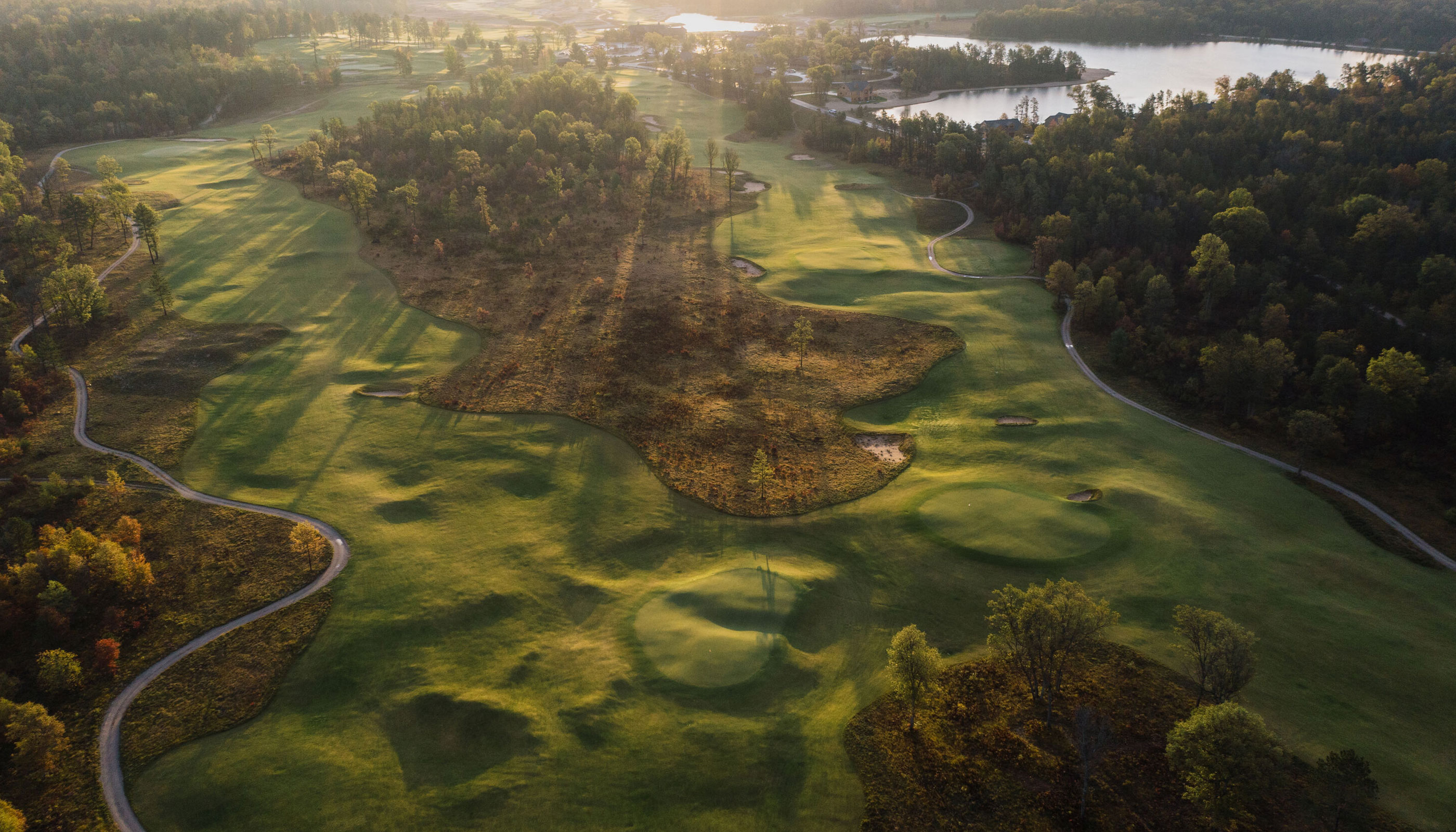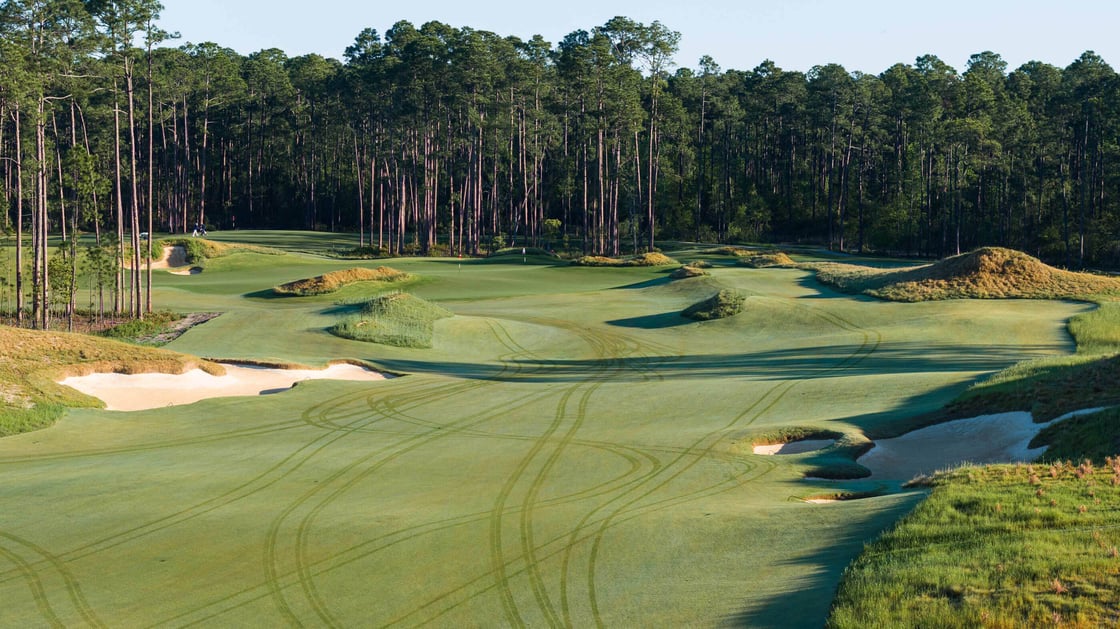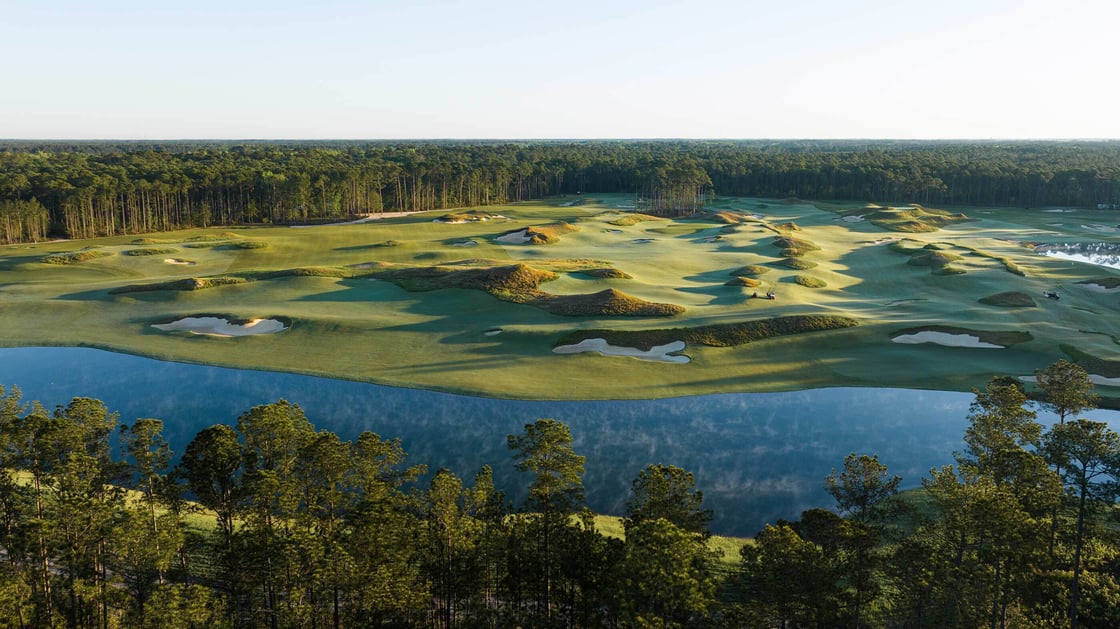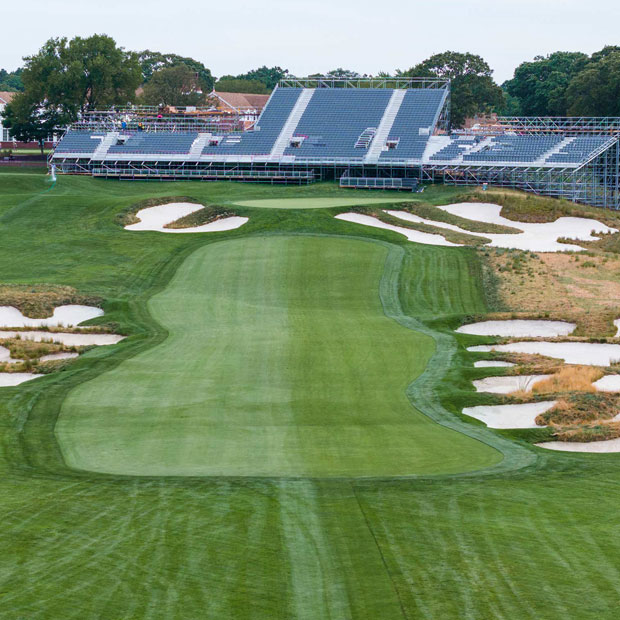Design Notebook: Is Today’s Golf Architecture Unoriginal?
Plus: progress at North Berwick, Formby, and Tepetonka


Hello, Fried Egg Golf Club. I’m Garrett Morrison, and welcome back to Design Notebook, your monthly digest of news and musings on golf architecture.
Have you exercised your right as an FEGC member to vote in the FEGC Hole Design Contest? The winning design will get built next year at Andy Staples’s new par-3 course, Ace Valley, at Breezy Point Resort in Minnesota. During last week’s FEGC hangout, a panel consisting of Staples, yours truly, and Fried Egg Golf founder Andy Johnson chose four finalists from a set of 12 semi-finalists (which were, in turn, selected from over 120 entries). Now it’s up to you to anoint a winner.
All right, on to this month's DN, which tackles the question of whether today’s golf architects are terribly unoriginal, caught up in repackaging ideas from 100 years ago.
Originality in Golf Architecture
The most common complaint I see about current golf architecture is that it’s unoriginal.
Two weeks ago, kicking off our new FEGC community forum with a provocative topic, member “Peter M” wrote, “We can only have so many sand scrapes, template holes, and potato chip greens before it gets old.”
Recently, on X, Golf Digest architecture editor Derek Duncan has also been worrying about the supposed lack of originality in modern golf course design. “What confounds me about this era of golf course architects,” Duncan remarked, “is that they are not thinking like artists. The artistic urge is to break and dismantle and innovate, but almost everything we’ve seen for 25 years is based on fealty to the looks and ideas of the past. It’s like Manet and Monet never looked sideways at Romanticism.”
When I pressed Duncan about which golf architects he was calling unoriginal, he said, “Short answer: the field. Longer answer: as long as designers think everything they do has to be a variation on what was being done in the 1920s or 1910s [we’re] going to be in an endless loop.”
That’s quite an indictment of the profession. While Duncan did single out Mike Strantz, King Collins Dormer, Jackson Kahn, and Brian Schneider as standard bearers of originality in modern golf course design, he stood by his generalization. Even Schneider, Duncan claimed, is “grounded in post-Victorian architecture.” As long as we’re naming influences, though, I would add that King Collins Dormer and Jackson Kahn are equally, if not more, indebted to Mike Strantz. And Strantz himself learned much from Tom Fazio. And so on.
Having influences doesn’t mean you’re unoriginal. In fact, I think originality actually comes from engaging with influences — processing, emulating, and reformulating the stuff you love. But that’s a different topic.
A point of clarification, before I move on: while I don’t hesitate to argue with Derek when we find ourselves on different sides of debates about golf architecture, I respect him a great deal. No beef here.
That said, I found it an amusing bit of irony that Duncan is not the first Golf Digest architecture editor to accuse modern golf course design of lacking originality. (I guess golf architecture critics are just as derivative as golf architects.) Back in 2010, Ron Whitten made much the same argument in an article titled “Why the lack of innovation?” Here’s Whitten:
“The problem is, every architect worships the past — the 1920s or teens or even earlier — and molds designs to those ancient templates. As Pete Dye says, every hole’s a copy of some other hole. There is no hip-hop, rap, or even jazz in golf architecture; it’s all Stephen Foster and John Philip Sousa. Which means modern-day courses are gussied-up reproductions, with strategies conjured up by Old Tom Morris or Old Macdonald, bunker styled after Alister MacKenzie or George Thomas, and greens patterned on relics like the Redan, Biarritz, and Eden. In 150 years, nobody has been able to come up with a new concept for a green? If phone engineers thought like golf architects, our cell phones would still be attached to the wall.”
I must admit, Whitten's got bars.
But was he right? Halfway, maybe. Not all the way.
For example, the most relentlessly original golf architect of the 2010s and 20s has been none other than Tom Doak, one of the leaders of today’s supposedly hidebound industry. In the past decade and a half, Doak has built a C.B. Macdonald template gallery that feels more like a tribute to the Old Course (Old Macdonald), a fully reversible course (the Loop at Forest Dunes), a real-deal Irish links (St. Patrick’s), a high-tech transplantation of a lost Macdonald design to a Wisconsin sand plain (The Lido), a sporting par-68 layout (Sedge Valley), and a LiDAR-assisted blowup of a dull strip of land next to the St. Lucie Canal (Sandglass). If none of those projects seem innovative, then I have to ask what we mean by the word.
{{old-macdonald-template-gallery}}
At the same time, there is plenty of monkey-see, monkey-do in 2020s golf architecture.
We don’t need another template course, for instance. The idea of a Macdonald/Raynor-inspired design was edgy in 2010, when the Macdonald/Raynorssance was just beginning to stir. Now, not so much.
Also, if you can’t build a naturalized bunker as well as the Coore & Crenshaw or Renaissance Golf Design crews do, please don’t try. It will look like what it is: a knockoff.
And one more: not every highly ranked Donald Ross course needs the bunkers and chocolate drops that Andrew Green built at Inverness in 2017. Much better to study the aesthetic that Ross or his foremen established on that specific site and work from there. Which, incidentally, is what Green did at Inverness and why the work came out so well.

So yes, I’d like to see current golf architects — particularly those specializing in Golden Age “resto-vations” and juggling many commissions at once, like Andrew Green, Tyler Rae, and Gil Hanse — ask each client, "What’s special about your course?" Don’t look across town; don’t look at the latest top-100 ranking. Dive into your architecture, your history, your place, and let the architectural stewardship proceed from there.
But where I really disagree with Duncan and Whitten is that artistic originality should be a primary goal for a golf architect.
Golf architecture is not a pure art like poetry or painting or music. The intention is not only to create something beautiful; it's also to prepare a ground for the game. Golf courses aren’t just observed. They’re used.
That’s why artistically experimental golf courses can be, frankly, annoying. Take the work of Desmond Muirhead, whom Whitten praised for showing “chutzpah in drawing inspiration from art, literature, and Mother Nature.” Whitten also acknowledged, however, that Muirhead “went off the deep end with fish bunkers and mermaid holes.” Right. Muirhead, for all his admirable creativity and conviction, may have forgotten at times that his main task was to prepare a ground for the game. And golfers seem to have tired quickly of his weird shit.
We tend to enjoy ourselves most on a golf course when we’re least aware of the architect’s hand. That’s because we crave contact with nature. We want to imagine ourselves doing battle with the wilderness, not with some ASGCA member’s fussy landscaping. Alister MacKenzie knew this, and it was why he was obsessed with the art and science of camouflaging earthworks. Bill Coore knows it, too. I think that’s why he deflects questions about his “style.” He doesn’t see himself as having one; his understanding of golf course design is entirely rooted in his response to the natural world.
Is Bill Coore unoriginal? Has he repeated himself on every project since Sand Hills? I wouldn’t put it that way. He’s just humble enough to recognize that most golfers desire nature (or at least a convincing simulation of it), not Bill Coore’s art.
The harder golf architects strive for artistic originality, the more they tend to forget golf’s primal connection to the natural landscape.
Last year, I visited the then-new Crossroads course at Palmetto Bluff, designed by Tad King and Rob Collins. I’ve enjoyed the work of King Collins (now King Collins Dormer) elsewhere, and Crossroads is nothing if not innovative: a reversible nine-holer with rambling, multilevel greens, each containing two pins. A feast! If I could play it every day, I’m sure I would find satisfaction in exploring its many intricacies. But I just didn’t like it. I wasn’t moved by Crossroads, and I couldn’t figure out why for a long time. Eventually I got it: this was a course that wouldn’t let me forget about its architecture. For me, Crossroads is over-designed, over-eager to prove its own originality, and divorced from its natural setting as a result.


King Collins Dormer isn’t alone in occasionally doing too much. Among many up-and-coming golf architects, I sense an anxiety to establish a unique style and differentiate from the still-competitive giants of Coore & Crenshaw and Doak. Some have done so successfully. See: Brian Schneider and Blake Conant’s fresh and exciting work at Old Barnwell. For the most part, though, the drive for originality has not produced outstanding golf architecture. Bold and energetic, sure. But also sometimes overcooked and unnatural-feeling.
I would like to see today’s rising golf architects pull back a bit. Do less.
It’s a common refrain that we haven’t moved past the era of minimalist golf architecture, which Coore, Doak, and Mike Keiser ushered in 30 years ago. But that’s not really true. Hardly anyone builds minimalist golf courses anymore. Many are trying to be naturalists, emulating the forms of nature with painstaking swipes of an excavator bucket, but just about everyone is reshaping sites from wall to wall these days.
As odd as it might sound, then, one of the most daring, punk-rock things a young golf architect could do right now is to be an actual minimalist. Not to pursue the kind of excess that critics often mistake for originality, but to use as light a touch as possible. To refuse the mantle of artist and the pressure to be innovative. To render themselves invisible to the golfer.
But does anyone have the guts?
Chocolate Drops
Note: I posted last week’s Chocolate Drops in Fried Egg Golf Club’s new community forum. Check it out!
At the great West Links at North Berwick Golf Club, Clyde Johnson is helping to restore the shape and dimensions of a famous green-side bunker on the third hole. This project continues a broader restoration plan, headed up by Johnson and course manager Kyle Cruickshank. Two years ago, I documented their efforts to bring back the full scale of the Redan bunker.
{{inline-course}}
With architects Joe McDonnell and Sam Cooper, Formby Golf Club in Liverpool, England, is implementing some simple, meaningful changes to its par-4 seventh hole. Excellent insights in this X thread.
Tepetonka, a new private golf course in Minnesota designed by OCM Golf, posted drone footage of all 18 holes on Instagram last Saturday. The turf is still struggling a bit after some flooding last winter. FEGC member Michael Chadwick offered some smart commentary on the course in our community forum.
In case you missed it…
- The White House has begun to dump rubble from the ongoing East Wing renovation project on East Potomac Golf Links, a municipal course owned by the National Park Service and operated by the National Links Trust.
- Wild Spring Dunes, a Dream Golf resort in East Texas, will open eight holes of Tom Doak’s new 18-hole course on November 12.
- Nick Faldo’s new golf course in Qiddiya City, Saudi Arabia, is set to open in 2026.
- Sandpiper Golf Course in Goleta, California, is battling through local permitting processes in hopes of starting a golf course renovation by Tom Doak and a clubhouse reconstruction by Winick Architects sometime in the near future.
- The Plantation Course at Kapalua Resort reopened on November 10 after shutting down and losing the 2026 Sentry because of water restrictions on the island of Maui.
- Lawsonia Links has continued to make incremental improvements to its Langford & Moreau-designed course.
- Luton Hoo Hotel, Golf & Spa is vying to be selected as the venue of the 2035 Ryder Cup. To that end, Luton Hoo’s golf course will undergo a top-dollar renovation by European Golf Design, Justin Rose, and Gary Player (who may or may not think the Ryder Cup should be “abolished”).
- Mossy Oak Golf Club in West Point, Mississippi, has reopened, now private, after a renovation by Jerry Pate.
A Course We Photographed Recently
Royal Cinque Ports Golf Club (Deal, England)—18-hole course designed by Harry Hunter in 1899
{{royal-cinque-ports-golf-club-design-notebook-gallery}}
Underlined and Starred
"There should never be a line of demarcation which divides the fairway from the rough. It can serve no possible purpose; it is inartistic and reflects no credit on the work of the staff. The eye ought to be unable to detect where the fairway ends and the rough begins, even if the fairway consists of grass and the rough of heather. It is quite simple to obtain this result, although it may take a little more time.” -Tom Simpson
Have a topic or question you'd like discussed in Design Notebook? Contact Garrett at garrett@thefriedegg.com.
Leave a comment or start a discussion
Engage in our content with thousands of other Fried Egg Golf Club Members
Engage in our content with thousands of other Fried Egg Golf Members
Get full access to exclusive benefits from Fried Egg Golf
- Member-only content
- Community discussions forums
- Member-only experiences and early access to events















Leave a comment or start a discussion
Lorem ipsum dolor sit amet, consectetur adipiscing elit. Suspendisse varius enim in eros elementum tristique. Duis cursus, mi quis viverra ornare, eros dolor interdum nulla, ut commodo diam libero vitae erat. Aenean faucibus nibh et justo cursus id rutrum lorem imperdiet. Nunc ut sem vitae risus tristique posuere. uis cursus, mi quis viverra ornare, eros dolor interdum nulla, ut commodo diam libero vitae erat. Aenean faucibus nibh et justo cursus id rutrum lorem imperdiet. Nunc ut sem vitae risus tristique posuere.